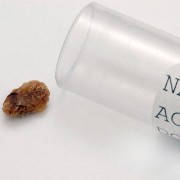 Photo: Getty Images
Photo: Getty Images
In many of us, kidney stones are formed over a period of time from the crystallization or solidification of dissolved minerals in the urine. More often than not, small specks of stones pass out through urine without any symptoms, but if the stones are larger (say, the size of a pearl) or there are many tiny stones stuck in the urinary tract, then symptoms such as pain in the lower back, fever, vomiting or blood in the urine may occur and you may require medical intervention. Both mainstream and alternative medical systems have found to be effective and successful in the management of this condition. Among others, reflexology offers a safe and pain-free alternative to tackle kidney stones.
ESSENTIAL OIL MIX*:
• Option A:
Carrier Oil - 2 ounces of Safflower Oil
Top Note Oil – 2 drops of Eucalyptus Oil
Middle Note Oil – 2 drops of Fennel oil (Caution! Not to use during pregnancy; may cause skin irritation, not to be used by epileptics, causes toxicity with overuse)
Base Note Oil – 2 drops of Cedarwood Oil (Caution! Not to use during pregnancy; also may cause skin irritation)
• Option B:
Carrier Oil - 2 ounces of Safflower Oil
Top Note Oil – 2 drops of Lemon Oil (Caution! May cause skin irritation)
Middle Note Oil – 2 drops of Geranium Oil (Caution! May irritate sensitive skins and an emmenagogue)
Base Note Oil - 2 drops of Sandalwood Oil
REFLEXOLOGY TREATMENT:
If you have the option of seeking a solution from a certified Aromatherapist or a licensed Holistic Health Therapist, you should choose it over attempting tackling pain at home. Let us take a look at how Reflexology approaches and manages discomfort in kidney stone patients. Chiefly, discomfort from kidney stones is managed by pressing at the areas that pertain to reflexes of kidney, urinary bladder and the intestines.
Foot Relaxation:
1. The therapist holds the patient’s left foot using both hands. The therapist places her fingers on top of the patient’s foot and the thumb at the base/ balls of the patient’s foot.
2. Then the foot is ‘loosened’ with a back and forth movement - big toe is gently brought forward and the little toes are gently pushed backward simultaneously.
3. This is followed by toe rotation for each toe of the left foot - clockwise and then counter-clockwise rotations.
4. Then, a foot wringing technique is added - first gently and then with moderate intensity.
5. Lastly, for relaxation, an ankle rotation technique is executed, where the therapist holds the patient’s foot at the base of the big toe with the left hand and the ankle is held with the right using it as a pivot to rotate the foot gently in a 360 degree circle.
6. The relaxation techniques 1 - 5 are then performed for the right foot.
Pertinent Reflexes:
1. The reflexologist will begin with his/her thumb in a vertical position at the centre of the left foot and with a rolling and pressing technique, work on your kidney reflex. The kidney reflex is located on the lower half of the foot towards the inner arch (an inch away from the inner arch). It is a small kidney-shaped area.
2. The reflexologist will then walk their thumb down the reflex of the urethra tube and work the urinary bladder reflex. The urinary bladder reflex is adjacent to the outer wall of the foot on the upper half of the heel of the foot.
3. Now the hands are reversed and the opposite thumb to work on the tube, following it up to the kidney reflex.
4. Steps 1-3 will be repeated for a good five minutes.
5. Now, the therapist uses a pressing and rolling technique for the area that corresponds to the small intestine, first on the left foot. The location for the small intestine reflex on the foot is approximately midway in heel of the foot, towards the inner arch side, about half an inch from the edge.
6. Next, the area that is the reflex of the large intestine is addressed. This is in the same horizontally straight line from the point of the small intestine, half an inch from the outer edge of the foot.
Concluding Massage:
1. As the therapist ends her session, she gives a 90 second relaxation massage to the patient’s whole foot for both legs using the press and slide technique and foot loosening techniques only.
2. Therapists conclude by wiping the patient’s feet for excess essential oils, with damp cotton wool.
*Please note that only therapeutic grade oils should be used for therapy. All Essential and Carrier Oils can start an allergic reaction on sensitive skin and most of the oils should not be used during pregnancy. Some oils are harmful to conditions of epilepsy, etc. Do not use any oil whose aroma you are uncomfortable with. Consult your Aroma Therapist or Holistic Health Therapist before using any oil.
Benefits, side-effects, prior preparations, costs, duration of procedure, recovery and resumption of daily activities as well as support issues should be discussed with your therapist for each type of treatment option before starting on your treatment.
Mamta Singh is a published author of the books Migraines for the Informed Woman (Publisher: Rupa & Co.), the upcoming Mentor Your Mind (Publisher: Sterling Publishers) and An Urban Woman's Integrated Fitness Guide (Publishers: Hay House). She is also a seasoned business, creative and academic writer. She is a certified fitness instructor, personal trainer & sports nutritionist through IFA, Florida USA. Mamta is an NCFE-certified Holistic Health Therapist SAC Dip U.K. She is the lead writer and holds Expert Author status in many well-received health, fitness and nutrition sites. She runs her own popular blogs on migraines in women and holistic health. Mamta holds a double Master's Degree in Commerce and Business. She is a registered practitioner with the UN recognised Art of Living Foundation. Link: http://www.migrainingjenny.wordpress.com. Visit www.mamtasingh.com





Add a CommentComments
There are no comments yet. Be the first one and get the conversation started!